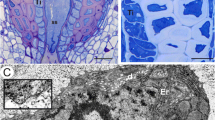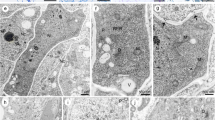Summary
During seed development the gynaeceum ofAptenia cordifolia produces a mucilage rich in carbohydrates and protein. The mucilage-producing placentary papillae are analyzed in different developmental stages by electron microscopy. Just before mucilage production is started, the rough ER occurs but sparsely. At that time the dictyosomes are inconspicuous and of low activity. When mucilage production commences, one can observe hypersecretory dictyosomes and ER-ensheathed vacuoles (storage vesicles) as the main structural components. It is suggested that the complexes of rough ER and probably fused Golgi vesicles are the synthetizing units of the carbohydrate protein mucilage, since in these complexes both components can be identified cytochemically. Fusion sites of plasmalemma and vesicles indicate processes of exocytosis-probably involving the Golgi apparatus. In addition, a holocrine excretion of the mucilage initially enclosed in the storage vesicles via degeneration of the protoplast is assumed.
Zusammenfassung
Der Fruchtknoten vonAptenia cordifolia enthÄlt wÄhrend der Samenentwicklung einen proteinreichen Polysaccharidschleim. Verschieden alte schleimproduzierende Placentarpapillen werden einer elektronenmikroskopischen Analyse unterzogen. Kurz vor dem Einsetzen der Schleimproduktion ist das rauhe ER noch spÄrlich entwickelt. Der Golgi-Apparat ist unauffÄllig und wenig aktiv. Zu Beginn der Schleimbildung sind als hauptsÄchliche Strukturkomponenten hypersekretorische Dictyosomen und ER-umschlossene Vakuolen (storage vesicles) zu beobachten. Es wird angenommen, da\ diese Komplexe aus rauhem ER und vermutlich mitèinander verschmolzenen Golgi-Vesikeln die charakteristischen Synthese-Einheiten für den Polysaccharid-Protein-Schleim darstellen, da sie nachweislich neben Polysacchariden auch Proteine enthalten. Membranfusionen zwischen Vesikeln und dem Plasmalemma deuten auf Exocytose-Prozesse unter Beteiligung des Golgi-Apparates hin. Daneben wird eine holocrine Ausscheidung des in den storage vesicles zunÄchst gespeicherten Polysaccharid-Protein-Schleimes bei Degeneration des Protoplasten vermutet.
Similar content being viewed by others
Literatur
Benner, U., undE. Schnepf, 1975: Die Morphologie der Nektarausscheidung bei Bromeliaceen: Beteiligung des Golgi-Apparates. Protoplasma85, 337–349.
Franke, W. W., andW. Herth, 1974: Morphological evidence forde novo formation of plasma membrane from coated vesicles in exponentially growing cultured plant cells. Exp. Cell Res.89, 447–451.
Hébant, C., andE. J. Bonnot, 1974: Histochemical studies on the mucilage-secreting hairs of the apex of the leafy gametophyte in some polytrichaceous mosses. Z. Pflanzenphysiol.72, 213–219.
Huber, J. A., 1924: Zur Morphologie vonMesembryanthemum. Bot. Arch.5, 7–25.
Jensen, W. A., 1962: Botanical histochemistry. San Francisco: W. H. Freeman and Co.
Kristen, U., 1974: Zur Feinstruktur der submersen Drüsenpapillen vonBrasenia scbreberi undCabomba caroliniana. Cytobiologie9, 36–44.
—, 1975: FeinstrukturverÄnderungen in den submersen Laubblattdrüsen vonNomaphila stricta Nees wÄhrend der Sekretion. Cytobiologie11, 438–447.
Mollenhauer, H. H., W. G. Whaley, andJ. M. Leech, 1961: A function of the Golgi apparatus in outer root cap cells. J. Ultrastruct. Res.5, 193–200.
Northcote, D. H., andJ. D. Pickett-Heaps, 1966: A function of the Golgi apparatus in polysaccharid synthesis and transport in root cap cells of wheat. Biochem. J.98, 159–167.
Paull, R. E., andR. L. Jones, 1975: Studies on the secretion of maize root-cap slime. III. Histochemical and autoradiographic localization of incorporated fucose. Planta (Berl.)127, 97–110.
Rosen, W. G., andH. R. Thomas, 1970: Secretory cells of lily pistils. I. Fine structure and function. Amer. J. Bot.57, 1108–1114.
Rougier, M., 1965: Ultrastructure des squamules d'Elodea canadensis (Hydrocharitacée) etPotamogeton perfoliatus (Potamogetonacée). J. Microsc.4, 523–530.
Schnepf, E., 1969: Sekretion und Exkretion bei Pflanzen. Protoplasmatologia VIII/8. Wien-New York: Springer-Verlag.
—, 1973: Mikrotubulus-Anordnung und -Umordnung, Wandbildung und Zellmorphogenese in jungenSphagnum-BlÄttchen. Protoplasma78, 145–173.
—, 1975: Special cytology: Morphology and morphogenesis of cells of higher plants. Progress in Botany37, 30–36.
Spurr, A. R., 1969: A low-viscosity epoxy resin embedding medium for electron microscopy. J. Ultrastruct. Res.26, 31–43.
Unzelman, J. M., andP. L. Healey, 1974: Development, structure, and occurrence of secretory trichomes ofPharbitis. Protoplasma80, 285–303.
Vigil, E. L., andM. Ruddat, 1973: Effect of gibberellic acid and actinomycin D on the formation and distribution of rough endoplasmic reticulum in barley aleurone cells. Plant Physiol.51, 549–558.
Welk, Sr.M., W. P. Millington, andW. G. Rosen, 1965: Chemotropic activity and the pathway of the pollen tube in lily. Amer. J. Bot.52, 774–781.
Yamada, Y., 1965: Studies on the histological and cytological changes in the tissues of pistil after pollination. Jap. J. Bot.19, 69–82.
Author information
Authors and Affiliations
Rights and permissions
About this article
Cite this article
Kristen, U. Die Morphologie der Schleimsekretion im Fruchtknoten vonAptenia cordifolia . Protoplasma 89, 221–233 (1976). https://doi.org/10.1007/BF01275741
Received:
Issue Date:
DOI: https://doi.org/10.1007/BF01275741




